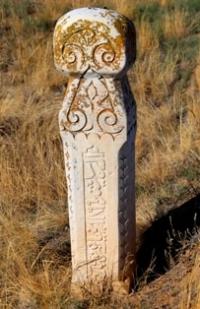You are here
Kulpytasy of Abat-Baytak necropolis.

Monuments of the Aktobe region.
“When dismantling the monuments, do not touch the pedestals. They may still come in handy.”
Stanislav Jerzy Lets.
Historical sights of Aktobe region.
Kulputasy of the Abat-Baitak (Baytakmola) necropolis is located 872 meters east of the drying out channel of the Batpakty stream, 18 kilometers southeast of the regional center of Kobda, 12.7 kilometers south and slightly west of the Taldysai village in the Khobdinsky district of the Aktobe region.
The Abat Baitak Mausoleum is the center of formation "to the south, west and northwest of it of the Kazakh necropolis of the XVIIIth - early XXth centuries, which includes the raw mausoleum of the late XVIIIth - early XIXth centuries, apparently built in imitation of the early monument, and the ensemble magnificent carved stele-kulpytas (over 200) "(5, 54 - 55).
Kulpytasy of various elaboration and compositional solutions were mainly set on the western side of the earthen embankment. The uniqueness of the necropolis is that not one kulpytas is like another. In the cemetery there are steles of petrified wood, planar simple kulpytases, high-tech carvings, voluminous steles, monuments in the form of a pedestal, etc.
In addition to carvings with floral and geometric ornaments, armaments and women's jewelry were sometimes depicted on the stela. In most cases, an epitaph containing the Quranic text and information about the deceased was knocked out on the western side.
Tamga of Kazakh clans was knocked out in many kulpytas: tabyn, kete, alshyn, baybakty, shchety, etc. Each kulpytas is unique. The only author who is known for them is Myktybai Toschi. His name is displayed on some of them. Such kulpytasy was not established for every mortal.
The stones were delivered, according to researchers, from Mangistau by a camel caravan. They easily succumbed to processing and in the hands of masters turned into real stone-cutting art. Mostly in the kulpytas - Arabic script, the origin of what kind of deceased is indicated.
To do this, tamga is bred on stone. According to it, scientists determined that influential people from the genus Tabyn, Shekty, Kete, Ogry, etc. rest here. Masters of stone carving art used geometric and plant shapes on some of the kulpytas.
In the western part of the necropolis there is another kulpytas, which is not at all like the others, and in a single copy. This is a wooden stele that has hardened and petrified by lightning. They call it that - petrified tree Archaic and early types of steles stand out among them, such as, for example, kulpytas, remarkable for its simplicity, representing a petrified tree, dug at the western sole of the grave mound.
This monument is a fairly transparent retrospection on the genesis of Kazakh kulpytases.
Kulpytas of 1785 - 1786 should also be attributed to the early type. - A simple faceted pillar with a semicircular finish. The planes of the stele are filled with Arabic epigraphy of religious content, which simultaneously plays a decorative role and is accompanied by tamga signs.
Judging by the tamgas, representatives of various clans of the Younger Zhuz were buried on the necropolis: tabyn, kete, alshyn, baibact, etc. For the majority of the later (XIX century) stelae of the necropolis, a combination of epigraphy and decor itself is characteristic, the latter prevailing, thereby emphasizing kulpytasy like glyptic monuments.
In this relationship, one can distinguish high examples of an elegant stone-cutting school of the mid-19th century. With the finest details. Often volumetric and decorative elements are solved in the tradition of wood carving.
Plant motifs are very popular on the monuments of the necropolis and are often expressed in a volumetric solution to the composition of steles - figured foundations in the form of flower stems, the top in the form of an unopened bud, etc.
On the whole, of course, the kulpytases of the Abat Baitak necropolis are executed in the spirit of a common concept for the development of art stelae for Western Kazakhstan. A large group of monuments refers to the characteristic type of massive steles with a pronounced volumetric-geometric solution of the constituent elements.
However, among this type, the traditions of the local stone-cutting school are accented. It is also worth highlighting the original kulpytasy - tombstones of the late 19th century, a specific feature of which is a pronounced architectural and spatial interpretation of the monument, uncharacteristic of vertical stelae.
Geographic coordinates of the kulpytas of the Abat-Baytak necropolis: N50 ° 05'45.30 "E55 ° 54'24.73"
Authority:
http://e-history.kz http://www.madenimura.kz, R. Beknazarov (Kazakhstan), Zhubanysh Baigurinov (Kobdinsky district, Aktobe region).
Photos
Alexander Petrov.







